Our Approach
At WellPath Prime, we believe the physician–patient relationship is still one of the most powerful tools in healthcare.
- APPROACH
Unlike other longevity platforms
Our platform enables patients to partner directly with their own doctor to build and follow a personalized, data-driven plan. We equip both physicians and patients with the tools to navigate it together, through our intelligent platform and mobile app.
that require patients to work with unfamiliar third-party providers—then try to relay that care back to their primary physician—we integrate it all.

- Comprehensive Data Collection
We begin where most platforms stop—integrating lab data, preferences, and behavior.
Your longevity plan shouldn’t just be clinically accurate—it should be personally achievable. That’s why we combine biomarker panels with lifestyle insight.
Cardiovascular Health
Total Cholesterol
Total cholesterol measures the sum of all cholesterol types in your blood. While necessary for cell function, elevated levels are associated with increased cardiovascular risk and shortened lifespan.
LDL (Low-Density Lipoprotein)
Often referred to as “bad” cholesterol, high LDL contributes to arterial plaque buildup. Lower levels are associated with reduced risk of heart attack and stroke.
HDL (High-Density Lipoprotein)
HDL is the “good” cholesterol that helps remove LDL from the bloodstream. Higher levels are protective and linked to better heart and metabolic health.
Lipoprotein(a)
Lp(a) is a genetically influenced cholesterol particle that increases cardiovascular risk independent of other lipids. Early detection is key, as levels don’t respond well to lifestyle changes.
Triglycerides
These fats in the bloodstream reflect how your body processes and stores energy. Elevated triglycerides are linked to insulin resistance, heart disease, and metabolic aging.
ApoB (Apolipoprotein B)
ApoB counts all atherogenic particles, offering a clearer risk profile than LDL alone. Lower ApoB is associated with reduced cardiovascular and all-cause mortality risk.
Omega-3 Index
This index measures the proportion of anti-inflammatory omega-3 fatty acids in red blood cells. Higher levels are linked to reduced cardiovascular death and slower biological aging.
RDW (Red Cell Distribution Width)
RDW measures the variation in red blood cell size, which can indicate inflammation, nutrient deficiencies, and early disease. Elevated RDW is associated with increased mortality risk.
Sleep
Magnesium (RBC)
This test measures magnesium inside red blood cells, where it’s biologically active. Magnesium supports deep sleep, muscle recovery, and nervous system balance—key for long-term vitality.
Vitamin D
Vitamin D regulates sleep quality, immune strength, and hormone function. Optimal levels are associated with lower risk of chronic disease and improved mood and sleep.
Serum Ferritin
Ferritin reflects stored iron levels. Both low and high ferritin can disrupt sleep, impair energy levels, and are linked to aging-related decline in endurance and cognition.
Total Iron Binding Capacity (TIBC)
TIBC assesses your blood’s ability to transport iron. Abnormal levels may indicate poor nutrient absorption or chronic inflammation, both of which can impair sleep and recovery.
Transferrin Saturation
This ratio of iron to TIBC gives insight into how well iron is utilized. It helps flag potential fatigue and sleep disturbances tied to nutrient imbalance or hidden inflammation.
hs-CRP (High-Sensitivity C-Reactive Protein)
hs-CRP is a marker of systemic inflammation, including that caused by poor sleep. Chronic elevation is associated with higher risk of cardiovascular disease and accelerated aging.
Inflammation
White Blood Cell Count (WBC)
WBC reflects the activity of your immune system. Chronic elevation or suppression can signal underlying inflammation or immune dysfunction—both risk factors for accelerated aging.
Neutrophils
These first-responder immune cells increase with stress and infection. Persistent elevation is linked to chronic inflammation and poor resilience to age-related diseases.
Lymphocytes
Lymphocytes are essential for targeted immune responses. Imbalances—either high or low—can reflect poor immune coordination, stress overload, or hidden infections.
Neutrophil-to-Lymphocyte Ratio (NLR)
NLR is a powerful marker of systemic inflammation and biological stress. Elevated ratios correlate with increased risk of heart disease, frailty, and shorter lifespan.
Eosinophils
These immune cells respond to allergies, infections, and inflammation. Chronically high eosinophils are associated with immune dysregulation and reduced recovery capacity.
Metabolism
HbA1c (Hemoglobin A1c)
HbA1c reflects your average blood glucose over the past 2–3 months. Keeping it in the optimal range helps reduce the risk of diabetes, cardiovascular disease, and early cognitive decline.
Fasting Glucose
This marker shows your baseline blood sugar after fasting. Chronically elevated levels are a hallmark of insulin resistance and metabolic aging.
Fasting Insulin
Fasting insulin is an early indicator of how well your body regulates blood sugar. Elevated levels often precede glucose issues and are tied to fat storage, fatigue, and shorter lifespan.
HOMA-IR (Insulin Resistance Index)
HOMA-IR is a composite marker of insulin sensitivity. Lower scores indicate better metabolic flexibility, which supports weight management, hormone balance, and longevity.
ALT (Alanine Aminotransferase)
ALT is a liver enzyme used to assess liver stress or damage. Elevated ALT is associated with fatty liver disease, metabolic syndrome, and higher mortality risk.
GGT (Gamma-Glutamyl Transferase)
GGT reflects oxidative stress and liver detox capacity. Even slight elevations are linked to increased risk of cardiovascular disease and all-cause mortality.
Testosterone
Testosterone supports metabolism, energy, muscle mass, and mood. Balanced levels in men and women are associated with healthy aging and preserved vitality.
Uric Acid
While a natural antioxidant in small amounts, high uric acid contributes to inflammation and metabolic dysfunction. Elevated levels are linked to gout, kidney strain, and cardiovascular risk.
Alkaline Phosphatase
This enzyme supports bone and liver health but can indicate dysfunction when outside optimal range. Elevated levels are associated with inflammation, oxidative stress, and aging-related conditions.
Cognition
Homocysteine
Homocysteine is an amino acid linked to vascular inflammation and brain aging. Elevated levels are associated with increased risk of dementia, stroke, and cognitive decline.
Cortisol (Morning)
Morning cortisol should peak shortly after waking, supporting alertness and metabolic activation. Blunted or elevated responses are linked to fatigue, mood imbalance, and accelerated aging.
Cortisol (Afternoon)
Afternoon cortisol should gently taper. Dysregulation may reflect chronic stress or adrenal fatigue, both of which impair cognitive function and long-term vitality.
Cortisol (Night)
Nighttime cortisol should be at its lowest to allow for deep sleep and cellular repair. Elevated evening cortisol disrupts sleep architecture and speeds biological aging.
24-Hour Urinary Cortisol
This test captures your total cortisol output over a day. Both high and low values may signal burnout, chronic stress, or poor resilience—core drivers of cognitive aging.
Hormone Balance
Estradiol
Estradiol is the primary form of estrogen, crucial for reproductive, cognitive, and cardiovascular health. Balanced levels support bone density, mood, and healthy aging across sexes and life stages.
Progesterone
Progesterone regulates mood, sleep, and menstrual health. Inadequate or misaligned levels can lead to fatigue, anxiety, and disrupted hormonal signaling over time.
TSH (Thyroid-Stimulating Hormone)
TSH controls your thyroid, the master regulator of metabolism. Both high and low levels are linked to fatigue, weight gain, cognitive dysfunction, and shortened lifespan.
Calcium (Serum & Ionized)
Calcium is essential for muscle function, bone health, and nerve signaling. Tight regulation is critical—both low and high levels are linked to heart disease, osteoporosis, and mortality risk.
DHEA-S
DHEA-S is a longevity hormone that supports immune balance, mood, and stress resilience. Optimal levels are associated with delayed biological aging and better physical performance.
Endurance
Ferritin
Ferritin reflects iron storage and oxygen-carrying capacity. Low levels impair stamina and recovery, while excess iron is linked to oxidative stress and chronic disease.
Iron
Iron is essential for delivering oxygen to tissues during activity. Both deficiency and overload impact endurance, fatigue, and long-term cardiovascular health.
MCH (Mean Corpuscular Hemoglobin)
MCH measures the average amount of hemoglobin per red blood cell. It affects oxygen delivery, and suboptimal values may indicate anemia or nutrient imbalance that reduces exercise capacity.
MCHC (Mean Corpuscular Hemoglobin Concentration)
MCHC evaluates the density of hemoglobin in red cells. It’s used to detect subtle deficiencies that can reduce energy levels and impair aerobic performance.
MCV (Mean Corpuscular Volume)
MCV assesses red blood cell size, helping detect early nutrient imbalances. It’s often one of the first indicators of low endurance potential due to anemia or inflammation.
RBC (Red Blood Cell Count)
Red blood cells transport oxygen throughout the body. Adequate levels are crucial for energy, brain function, and physical performance—strong predictors of healthy aging.
Platelet Count
Platelets are key to clotting and healing. Both high and low counts may signal inflammation, immune stress, or recovery challenges that reduce resilience over time.
FITNESS
Free Testosterone
Free testosterone is the active form of testosterone that directly affects muscle mass, strength, mood, and energy. Optimal levels support vitality, physical performance, and metabolic health as you age.
SHBG (Sex Hormone-Binding Globulin)
SHBG controls the availability of sex hormones like testosterone and estrogen. Imbalances can limit hormonal effectiveness, impacting muscle development, recovery, and longevity.
VO₂ Max
VO₂ max measures your body’s ability to deliver and utilize oxygen during exercise. It is one of the strongest predictors of cardiovascular health, physical capacity, and all-cause mortality.
Body Composition
Percent Body Fat
Body fat percentage reflects the balance between fat and lean mass. Maintaining optimal levels reduces chronic disease risk, supports metabolic health, and improves functional longevity.
SMM to FFM Ratio (Skeletal Muscle Mass to Fat-Free Mass)
This ratio highlights the quality of lean mass. A higher percentage of skeletal muscle is linked to better mobility, metabolic function, and protection against age-related frailty.
Waist-to-Hip Ratio
Waist-to-hip ratio is a strong indicator of visceral fat and cardiovascular risk. Lower ratios are correlated with longer lifespan and reduced risk of metabolic syndrome.
BMI (Body Mass Index)
BMI provides a general gauge of weight relative to height. While imperfect, staying in the optimal range is associated with lower disease burden and improved healthspan.
Immune & Renal Function
Albumin
Albumin is a protein produced by the liver that reflects overall nutritional and inflammatory status. Higher levels within the normal range are associated with lower mortality and greater resilience.
Total Serum Protein
This marker captures the balance of albumin and globulins in your blood. Abnormal levels can indicate chronic inflammation, malnutrition, or kidney dysfunction—each of which can compromise longevity.
Hemoglobin
Hemoglobin carries oxygen in red blood cells. Low levels impair energy and organ function, while excessive levels may indicate underlying disease or poor oxygen regulation.
Hematocrit
Hematocrit measures the proportion of blood made up of red cells. Optimized levels support endurance, brain function, and cardiovascular health.
eGFR (Estimated Glomerular Filtration Rate)
eGFR reflects kidney filtration capacity. A declining eGFR with age signals increased risk of hypertension, toxin buildup, and chronic illness.
Cystatin C
A sensitive marker of kidney function and cardiovascular risk. Unlike creatinine, it’s not influenced by muscle mass, making it useful in aging populations.
BUN (Blood Urea Nitrogen)
BUN reflects how well your kidneys excrete waste. Both high and low levels are linked to nutrient imbalances, dehydration, and impaired longevity.
Vitamin B12
Essential for DNA repair, nerve health, and red blood cell production. Subclinical deficiencies are common with age and linked to fatigue, cognitive decline, and frailty.
Folate (Serum and RBC)
Folate supports methylation, detoxification, and cardiovascular health. Chronic deficiencies are tied to elevated homocysteine, poor cognition, and accelerated aging.

AI Recommendation Engine
Tailored plans driven by clinical science and intelligent automation.
Our proprietary AI analyzes your full biomarker panel, lifestyle inputs, and health history to generate personalized recommendations—then learns and evolves with each new data point.
Instead of cookie-cutter advice, you receive precision health strategies aligned with the latest longevity science, continuously refined as your profile evolves.
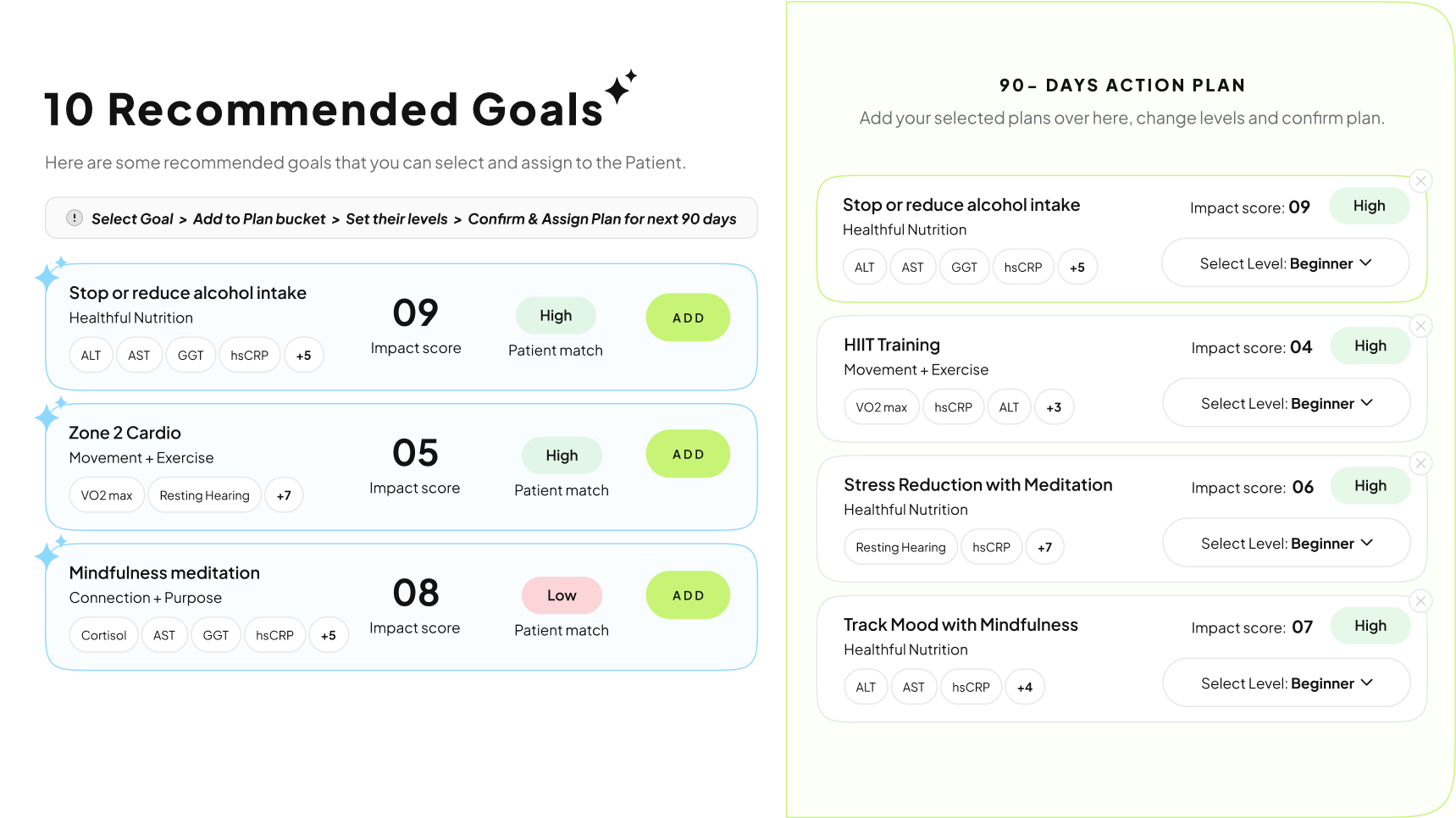
Longevity App
Track everything in one intuitive place
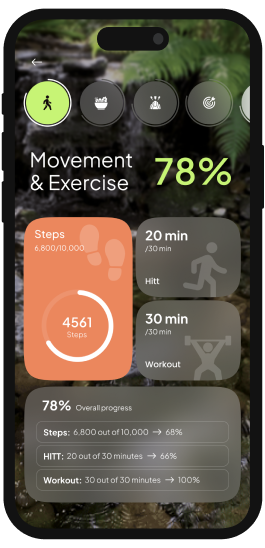
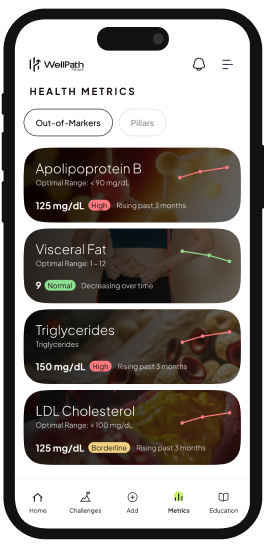
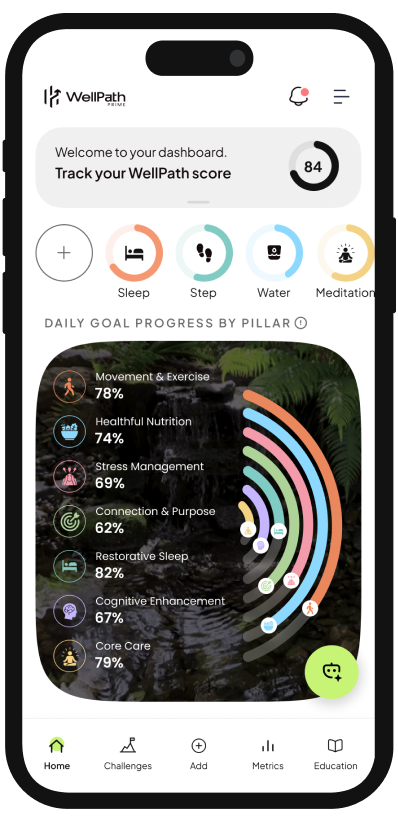

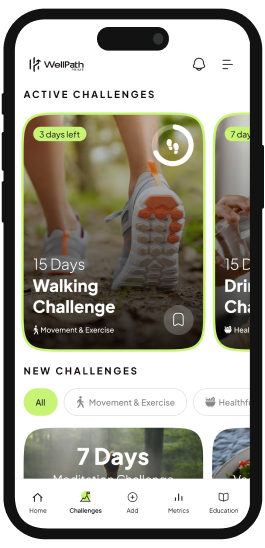
Stay aligned with your custom protocol and daily targets.
See biomarker changes over time, with AI summaries.
Receive smart prompts directly from your provider.
Dive into curated lessons that match your goals.
Build better habits—and track wins as you go.
- Oversight
clinician Oversight, Minimal Time Burden
Designed for high-impact, low-friction practice integration

View and monitor patient progress in real-time

See which recs drive the biggest improvements

Send nudges or follow-up messages

Zoom out for population-wide trends
*Doctors can choose to stay high-level or dive deep—flexibility is built in.
- Improvement
Built for Ongoing Improvement
Your plan evolves every 3–4 months as real-world feedback flows in.
Re-test key biomarkers
Revisit lifestyle goals
Update adherence data
*Each cycle generates a new plan—more personalized, more informed, and more effective.
- FEATURES
Key Features
What makes our longevity platform unique
WellPath Score
A dynamic index across 7 Longevity Pillars personalized to your journey.










